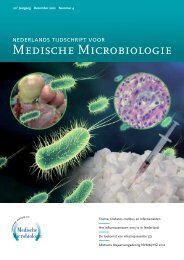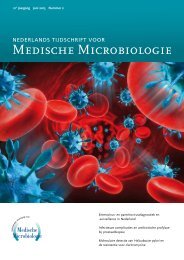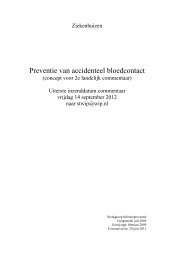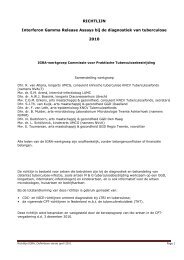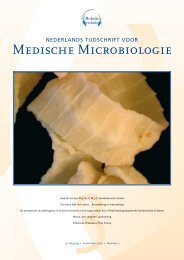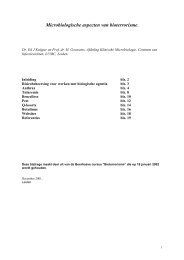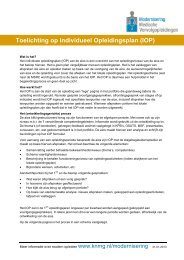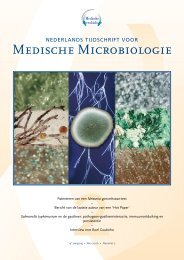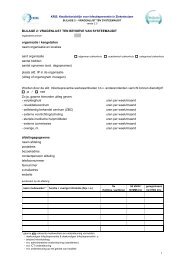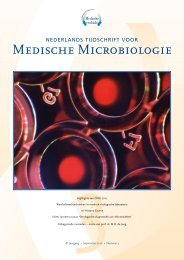Supplement bij veertiende jaargang, april 2006 - NVMM
Supplement bij veertiende jaargang, april 2006 - NVMM
Supplement bij veertiende jaargang, april 2006 - NVMM
You also want an ePaper? Increase the reach of your titles
YUMPU automatically turns print PDFs into web optimized ePapers that Google loves.
Cystic echinococcosis is caused by the larval stage of<br />
Echinococcus granulosus, the small tapeworm of dogs.<br />
Humans become infected by ingesting the parasite’s eggs<br />
that are shed with the feces of infected dogs. Hepatic<br />
involvement can result in abdominal pain and biliary duct<br />
obstruction. Pulmonary involvement can produce chest<br />
pain, cough, and hemoptysis.<br />
The diagnosis of cystic echinococcosis relies in most cases<br />
on clinical findings and imaging procedures combined<br />
with serology. Serological tests with high specificity and<br />
sensitivity are therefore essential. For this reason we<br />
evaluated the reactivity of IgG1 and IgG4 antibodies to E.<br />
granulosus cyst fluid antigens using the immunoblotting<br />
procedure. Sixty five serum samples from patients with<br />
proven echinococcosis were evaluated. For determination<br />
of specificity, sera from 87 patients with other<br />
parasitic and bacterial infections were studied. Antigens<br />
of 7, 14 and 24 kDa were recognized by IgG1 and IgG4<br />
antibodies from patients with cystic echinococcosis (CE)<br />
and not by patients with other infections. Evaluation of<br />
the specificity and sensitivity of the IgG1 in combination<br />
with the IgG4 immunoblots resulted in 99% specificity<br />
and 95% sensitivity. The immunoblots were also used for<br />
follow up of the immune response of treated CE patients.<br />
Results indicate that patients with good response to<br />
treatment showed decreased IgG1 and/or IgG4 response.<br />
The immunoblots here described have a higher specificity<br />
than the ELISA technique that is used in our laboratory for<br />
routine serological diagnostic of cystic echinococcosis. Due<br />
to the high sensitivity of the ELISA, we propose the use of<br />
the ELISA technique for screening purposes and the IgG1<br />
and IgG4 immunoblots to confirm the positive ELISA<br />
results. The combined results from the Echinococcus-IgG1<br />
and IgG4 are not only useful to serologically confirm<br />
an Echinococcus infection but it provides also additional<br />
information in follow up studies of treated patients.<br />
10.03<br />
Diagnosis of mumps by IgM-elISA in Scotland - an assay<br />
comparison<br />
C.H. Krause, K.E. Templeton<br />
Specialist Virology Centre Edinburgh, Laboratory Medicine,<br />
Edinburgh, United Kingdom<br />
Introduction: Since the end of November 2003, Scotland<br />
has seen an outbreak of mumps with over 4000 confirmed<br />
cases in the last 2 years. The incidence of mumps continues<br />
to be high, particularly in adolescents who were either<br />
unvaccinated or given a single dose of mumps/measles/<br />
rubella vaccine. Laboratory diagnosis is usually requested<br />
on patients with symptoms. Therefore prompt diagnosis<br />
on acute samples is required. Here, the performance of 5<br />
different commercial IgM assays was assessed.<br />
Ned Tijdschr Med Microbiol <strong>2006</strong>; 4:<strong>Supplement</strong><br />
S43<br />
Methods: The Specialist Virology Laboratory (SVC),<br />
Edinburgh, distributed a serum panel to all Scottish laboratories<br />
that perform mumps diagnosis by IgM-ELISA. The<br />
panel consisted of 45 true positive (TP) and 11 true negative<br />
(TN) serum samples. The TP samples had been confirmed<br />
by virus isolation on a parotid duct swab and/or a 4-fold rise<br />
by complement fixation testing (CFT) on a pair of serum<br />
samples. Date of sample collection after onset of symptoms<br />
(AOS) was recorded. The TN samples consisted of sera from<br />
patients with other infections. Five different commercial<br />
IgM-ELISAs were performed blindly: ELISAs Enzygnost ®<br />
Antiparotitis-Virus/IgM (Dade Behring), Mumps IgM<br />
(Human), Mumps IgM capture EIA (Microimmune Ltd),<br />
Mumps ELISA IgG/IgM (Virotech), and Enzywell Mumps<br />
IgM (Diesse). Results were all reported to SVC.<br />
Results: Sensitivity ranged from 51% to 24%; with the<br />
Microimmune assay being the most sensitive. Assays<br />
performed better on samples taken > 10 days AOS,<br />
although even then mumps-IgM was not detected by<br />
all assays. The Virotech assay was the only assay that<br />
reported mumps-IgM in all serum samples > 10 days AOS.<br />
Specificity was about 82% for most assays.<br />
Conclusion: The anti-mumps-IgM assays assessed are<br />
insensitive and inappropriate for use in acute specimens.<br />
This could be due to the fact that development of antimumps-IgM<br />
is delayed or suppressed in partially immune<br />
individuals. For acute diagnosis laboratories should be<br />
developing the means to direct detection by virus culture<br />
or PCR.<br />
10.04<br />
Use of Raman spectroscopy for the identification of<br />
Burkholderia spp.<br />
H.F.M. Willemse 1 , K. Maquelin 1 , M.J. Scholtes 1 ,<br />
P. Vandamme 2 , A. van Belkum 3 , G.J. Puppels 1<br />
1Erasmus MC, General Surgery/CODT, Rotterdam,<br />
2Universiteit Gent, Laboratorium voor microbiologie, Gent,<br />
Belgium, 3Erasmus MC, Medical Microbiology & Infectious<br />
Diseases, Rotterdam<br />
The Burkholderia cepacia complex (BCC) is a group<br />
of at least nine closely related species. In CF patients<br />
pulmonary BCC infections have a considerable impact<br />
on clinical outcome and may lead to a fatal decline in<br />
lung function known as cepacia syndrome. Members<br />
of the BCC are well recognized as nosocomial and<br />
outbreak related pathogens and are able to colonize CF<br />
patients. Species identification of BCC organisms can be<br />
obtained with phenotypic methods such as automated<br />
commercial systems. Identification using these systems<br />
is doubtful, so confirmatory identification with expensive<br />
and laborious molecular methods is required. A powerful<br />
and inexpensive tool for the rapid identification of micro-




